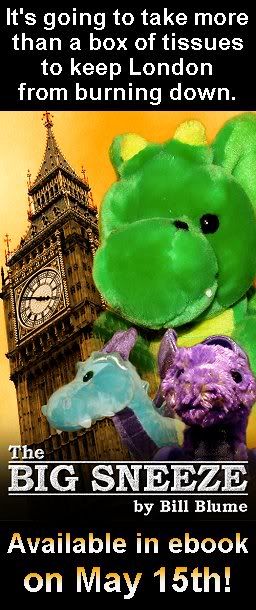
Leave it to
Jess to craft not only a timely Writer’s Weekly Question, but one of her best yet. She hits on the furor surrounding the release of the film adaptation to
The Da Vinci Code.
Writer's Weekly Question #16: Is there a point where authors of historical fiction cross the line and need to be rebuked? Is it wrong to fiddle around with historical events and make the story less than accurate for the betterment of the overall story being told (does this make sense?)?

This is such a difficult question to answer, but it’s also doubly timely for me as I’m reading another historical fiction thriller,
David L. Robbins’
The Assassins Gallery. I’ll come back to David’s book in a moment, though. First, I’ve got to give Jess credit for crafting a really compelling entry that offers a great comparison between Dan Brown’s
The Da Vinci Code and Alexander Dumas’
The Three Muskateers. If you haven’t read her entry yet, then you really should. Hopefully, I can offer one as interesting here.
Let’s get to the point I plan to make. Yes, I do think a writer can cross a line when it comes to tinkering around with events within historical fiction. I think most historical fiction writers choose this genre out of love for a certain time period. When a writer enters into a work of historic fiction for reasons other than a passion for the setting, that’s where I think we’re likely to see a writer cross a line they shouldn’t. I think it’s fine for a writer to change events within history for the purpose of a story, but such changes need to be made with a certain level of respect for the subject matter.

Allow me to present Exhibit A: Bernard Cornwell’s “Sharpe” series. My wife loves these books, and her passion for these books has infected me, as well. Cornwell does a great job of presenting the Napoleonic wars through the eyes of a lowly soldier named Richard Sharpe. Cornwell does a lot of research for these books, and the attention to detail shows… as does his love and respect for the subject matter. I was truly impressed by his historical note at the end of
Sharpe’s Eagle, perhaps Sharpe’s most famous adventure. In this historical note, not only does Cornwell detail the first time British soldiers really did capture a French “eagle,” but he even asks forgiveness of the soldiers’ ghosts for altering history to let Richard Sharpe capture the first eagle lest the dead soldiers haunt him!
Again in
Sharpe’s Company, Cornwell stretches historic events a bit to place Sharpe at the site of two separate sieges, the first as a crash course of sorts for how a siege works so the reader is better able to understand what’s ahead for Sharpe when he gets to the more significant siege on Badajoz. As with
Sharpe’s Eagle, Cornwell takes a moment at the end of his book to explain how unlikely it is for Sharpe and his men to have been at both sieges and offers a brief detail on how actual events did play out within the siege on Badajoz in 1812. That Cornwell takes the time to offer this confessional shows a respect for the history and a desire to not only entertain the reader but to educate them on the history itself.

Exhibit B: William Shakespeare’s “Macbeth.” Easily my favorite Shakespearean play, “Macbeth” has something of a checkered past. Back in college, I took a class on Shakespeare’s tragedies and was surprised to learn some of the truths behind this play. For example, while now considered one of his tragedies, it was sometimes grouped within… get this… his historical plays. That’s right. This weird tale with its three witches and scheming thane offers one warped view on this bit of Scottish history. The play portrays Macbeth as a villain who is tempted by his wife and a trio of witches to defy the will of the king and seize power for himself. Sounds plausible, except that by the law of the time, the king was the one violating the rule of the land by proclaiming his son as heir instead of Macbeth. The point is that the real Macbeth was the good guy. The play also adds the character of Banquo, a person the Stuart line fabricated to justify their royal claims. So why does this play warp these facts? England’s ruler at the time of Shakespeare’s play was King James I who was part of the Stuart line. In other words, Shakespeare purposefully rewrote history to appease England’s James I. Not only that, but the inclusion of the three witches was another bit owed to James I who wrote a text on the evils of witchcraft entitled
Daemonologie. Much as I love this play, I can’t deny Shakespeare appears to have played loose with the facts and with the intent of coloring, if not rewriting, history. Certainly not the great playwright’s brightest moment.
So there are my examples of historical fiction done right and wrong. So where does
The Da Vinci Code fall within this range? Like Jess, I also subscribe to the idea that all this brouhaha is much ado about nothing. It is indeed fiction, a detail Dan Brown has pointed out quite often since the success of his book. I do have to differ with Jess a bit on how the book presents itself, though. Yes, if one reads between the lines, they will realize Brown isn’t claiming this is how the past truly is but merely an interesting exploration into “What if?” Still, the tone of the book’s opening statement gives a false impression that we are being given the true facts.
Despite this, I’m truly baffled by Christians who feel the need for protests at movie theaters, because of the film version of
The Da Vinci Code. I admire their passion for their faith, but I think it’s misdirected. Such an extreme reaction only makes them look as if they’re on the defensive and do in fact have something to hide. On the other hand, the churches that have taken the opposite tactic of using
The Da Vinci Code as a learning tool to actually draw interest into Christianity have impressed me. These groups have recognized the potential to use this book as a talking point, a way to make the past relevant to the present. I’ve been reminded of how Christians reacted to the film “
The Last Temptation of Christ,” and it seems some Christians have learned from how many foolishly handled that challenge to Christianity.

So should Dan Brown have included some kind of closing historical note, in the fashion of Bernard Cornwell? I don’t think so. The story itself isn’t technically historical fiction, even if it does offer a fictional perspective on history. Brown already presents his facts about the past within the book, so any historical notes at the end would be redundant. I do think the introductory blurb needed to be reworded or eliminated. That little bit at the beginning is what empowers the rest of that book, because it gives the story’s theory a credibility it really doesn’t deserve. Why wasn’t Brown more careful with this? Well, had the book not turned into such a blockbuster, this wouldn’t even matter. The debate wouldn’t exist, and based on his previous books, he had no reason to think this time would be any different.
I think it would be far more interesting to get a reaction to Jess’ question from an actual historical fiction writer... and a successful one at that. With that in mind, I still hope to talk David L. Robbins into a “Wordslinger” interview for my blog once I finish reading his forthcoming
The Assassins Gallery. If he’s up for it, then you can rest assured I’ll see what he says to this Writer’s Weekly Question.
































































